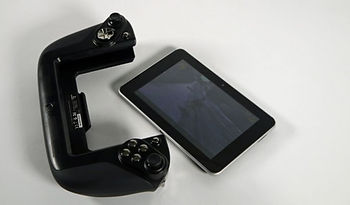
Since tablet PC's became the new fashionable accessory that sure enough will replace all laptops and most PC's as the future of home computing, us gamers have struggled with them. Yes, there are games available for them, and some of them look and play fantastically, if you can use the touch screen technology fast, or efficiently enough. We gamers don’t want that, we long for the feel of a controller in our hands. Something tangible, physical, that has buttons and d-pads etc., to make the game play as fluently as any other.
Well, the wait is finally over. Wikipad combines the much loved tablet PC and tailors it for gaming. How have they done this? It's simple. They have made a controller that allows the tablet to slide into it. So you still have the screen in your hands, but you also have the benefits of a controller too. The tablet itself will work in isolation to its interchangeable controller counterpart as well.
So, what can it do? Well, as tablets go these days, it’s competing fairly well in terms of spec for spec, sadly though, the screen itself is a little small for a tablet these days, as it comes in at 7 inches. But the display is 1280x800, and the screen itself is a scratch resistant "military grade" screen, according to their official specifications. The tablet has also used some big names in its build too. Such as using a NVIDIA Tegra processor, and a quad-core CPU, which is impressive for a tablet. The operating system is Android 4.2 (or Jelly Bean), and it has all the essentials of WI-FI, Bluetooth and access to external memory/storage sources.
The interchangeable controller counterpart to the tablet has all the trimmings that you would expect from a standard gaming controller, say for Xbox or PlayStation. It has dual analog sticks, trigger buttons, d-pad and the standard A, B, X, and Y buttons (or Square, Triangle, X and Circle for PlayStation users). Under each hand, and thumb, it feels pretty similar to any other controller that we would use, just our hands are further apart now, but this will be something that we get used to as there is a screen in between them. But it really felt good to hold, even if it did feel a little like a bigger, better PSP, or DS, and look like a re-modelled GameGear.
As we said earlier, the tablet can be used as a standard tablet, and then slipped into the controller for gaming. The touch screen facility doesn’t all together turn off, so it will still work as a touch screen if you received an email in the middle of the game, and wanted to quickly check it, before jumping back in the game. There would be no need to disconnect the controller, check the email, reconnect the controller and continue playing. In addition to this, the controller and tablet were created together, which means that full button mapping has already been incorporated into Wikipad. Initially, we found that there was a little issue on responsiveness of the controller, but after tweaking the calibrations a little, we soon resolved this issue.
Holding the controller and tablet to game feels quite light in your hand too. This could be that it is simply a lightweight plastic, or it could be the use of centre-of-gravity technology that has been used to create it, so that it virtually feels weightless and therefore, doesn’t contribute too much fatigue while using it. We were concerned that it might have, as often tablets by themselves become heavy when held for too long. With Wikipad, we found no issues with this.
So, we've looked at the main feature, and some of the other benefits that you will get from the Wikipad. However, whenever we look at reviewing anything, the one question that we always ask ourselves is, would we recommend the product to a friend or family member? The answer is not as simple as the question. As a tablet, it stands up to some of the other big names out there, and has everything that you would need to stay current and up to date with tech, coupled with the Android operating system make it great for all things app wise. The heavy tablet gamers will also completely benefit from the use of the controller aspect, and it certainly makes gaming easier and more fun for kids too.
However, the Wikipad is currently selling for around £230, which spec vs. spec make it around £100 more expensive than most other tablets of similar tech, which means that you are basically paying £100 for a controller attachment that, granted, is specifically designed for this tablet and works impressively for tablet based games such as shooters and racing games. However, we feel that for what you get in the box, it’s a little pricey, but is the only one of its kind at the moment.
Overall, the Tablet is fairly mid-range in the marketplace at the moment, and the brilliantly designed controller attachment is certainly a step in the right direction, and it will open up the eyes of other developers out there, to show them what is possible. However, it still needs a lot of work, and the price needs to be reducing a little before it begins to be a realistic competitor in the tablet, or even the gaming market. In hind-sight, they may want to think about scrapping the whole "isolated" or "exclusive" idea, and look into building universal, or tablet specific controllers for the tablets that already exist, and selling them as attachments, for a much cheaper price. Alternatively, another idea would be to design a Bluetooth or WI-FI controller that can connect to any tablet providing they have the software installed on the tablet in question.
So, in closing if you're a serious gamer, tech-head or have kids that would love a new gadget, then this would suit you fine. But if you're looking for a competitive tablet, or something that stands up in the gaming industry, then you should maybe look around a little before settling on a final decision.

Leighton Sutherland


Wikipad - The Future?







